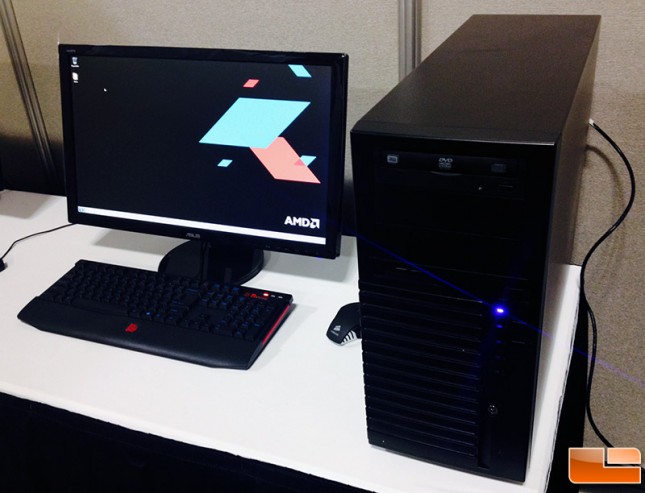AMD Radeon R9 390X Video Card Powers Demos At GDC
One of the stories from GDC last week that we should have published over the weekend is that we had a chance to see a system that contained an unannounced, next generation ultra-enthusiast class AMD Radeon R9 Series Graphics card. The story wasn’t that exciting to us since there was no way to actually confirm that is what was inside the system. AMD did not allow us to remove the side panel of the case or allow us to run an application that would show any GPU information. For all we know there could have been an NVIDIA GeForce GTX Titan X 12GB video card powering the AMD demo system! We have no reason to doubt AMD’s claim though and that the flagship Radeon R9 300-series graphics card is powering Epic Games’ Showdown virtual reality demo in AMD’s booth on the Crescent Bay Oculus headset.
Nothing else was told to us by AMD about their upcoming Radeon R9 graphics cards other than we’ll see it this summer. Internet rumors have the hardware specifications on the 390X GPU (Fiji XT) as having 4096 stream processors and 256 texture units built using Graphics Core Next (GCN) 1.2 architecture. The AMD Radeon R9 300 series will have major memory enhancements with the introduction of SK Hynixs stacked high bandwidth memory (HBM) chips that provide up to 640GB/s of bandwidth depending on what speed AMD ends up clocking them at. Right now the word on the street is that they are clocked at 1.25GHz, but we know that AMD likes to tweak clock speeds until the very last minute and the impending launch of the Radeon R9 300 series is still months away. The high-end Radeon R9 390 and 390X are expected to be using 4GB of the HBM memory and we expected all 4GB of that frame buffer to be accessible at the rated speeds. ON top of the new memory we also expect to see some other new technologies make it into the Radeon R9 390 series. For example some of the upcoming AMD Carrizo APU power saving features could also be headed to GPUs. Adaptive Voltage-Frequency Scaling (AVFS) sensors that enable smart voltage monitoring for power savings of up to 10% are said to be in the next-gen graphics cards. That might not sound that significant, but add the 10% power savings from that to the other power saving architecture improvements in the Fiji XT GPU and we could be talking about up to 20% power savings and also the ability to run higher clock speeds!
When it comes to performance the AMD Radeon R9 390X is rumored to be up to 50% faster than the Radeon R9 290X. It will be interesting to see how AMD was able to get such significant performance improvements if the rumors are real. With the increasing popularity of ultra-high-definition resolutions, such as 4K (3840×2160) and 5K (5120×2880), we hope that the AMD Radeon R9 390X proves to be as good as what some are making it out to be. That rendering power will also be needed down the road for when Virtual Reality takes off as it is clear you’ll need a powerful GPU for a great VR experience. AMD clearly sees the importance of VR and just last week announced their LiquidVR SDK.
It was reported that AMD lost some market share in the discrete desktop video card market, but releasing the AMD Radeon R9 300 series should help spur sales once again. AMD has also been doing a pretty good job at improving AMD Catalyst Drivers and released the mother of all drivers last year with the roll out of AMD Catalyst Omega drivers. From the chatter we are hearing from within AMD there will be other Omega driver updates coming in the future that promise more improvements and new features that are sure to keep AMD gamers happy with the red team.
The AMD Radeon R9 300 series launch date has not been announced, but AMD is expected to officially announce all new APUs and GPUs ahead of or during Computex 2015. Computex is in June, so we are roughly three months away from the next generation AMD Radeon R9 Series Graphics card and we couldn’t be more excited!

